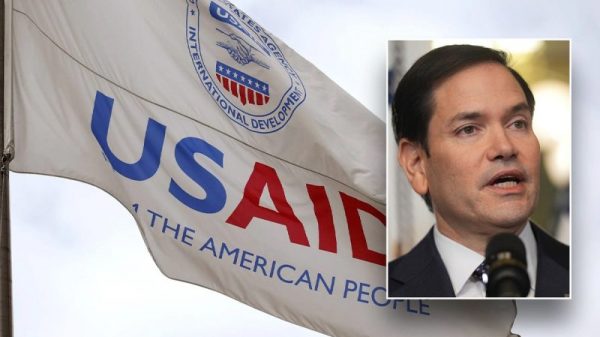Target and Walmart are both catering to thriftier shoppers, but the two big-box retailers have seen very different outcomes when it comes to winning their dollars.
Target missed Wall Street’s sales expectations for the fiscal second-quarter. Walmart beat Wall Street’s revenue estimates for the three-month period. Target slashed its forecast for the year, while Walmart raised its outlook.
The companies’ diverging performances illustrate some of the retailers’ fundamental differences.
Walmart, the nation’s largest grocer, makes more than half of its annual revenue from selling groceries — a category that shoppers buy even when times are tight. Target draws only about 20% of its yearly revenue from grocery, making it rely more on sales of items such as clothing, earrings and throw pillows that customers may skip when feeling frugal.
Target, which tends to draw a more affluent customer than Walmart, may also be seeing a more dramatic swing in spending as consumers shell out on Taylor Swift tickets and European vacations. Those shoppers could also be trying to balance splurging on services with shopping at places perceived to be cheaper, such as Walmart or TJX Companies-owned T.J. Maxx, Marshalls and Home Goods, which posted year-over-year sales and profit growth earlier this week.
Yet Target’s and Walmart’s contrasting results also capture how some retailers are having more success than others catering to fickle consumers and navigating economic headwinds.
More from CNBC:
Target Pride backlash adds to sales woes as culture wars rage in corporate AmericaTarget slashes full-year earnings forecast as retailer struggles to win over thrifty shoppersWalmart raises full-year earnings forecast as grocery, online growth fuel higher sales
Wall Street added to the confusion with its own counterintuitive moves. After earnings reports, it snapped up Target’s stock on Wednesday and sold off Walmart’s shares on Thursday. The potentially surprising moves could reflect the companies’ recent stock performance, since shares of Walmart are up about 10% this year compared with Target shares’ decline of about 13% during the same period.
Despite the differences, the companies showed they still have much in common. Target and Walmart leaders offered similar descriptions of American consumers who now think twice before spending money on nonessential items while paying more for food.
“As we look at the consumer landscape today, we recognize the consumer is still challenged by the levels of inflation that they’re seeing in food and beverage and household essentials,” Target CEO Brian Cornell said on a call with reporters. “So that’s absorbing a much bigger portion of their budget.”
Walmart Chief Financial Officer John David Rainey echoed similar sentiments, describing consumers as “choiceful or discerning” on a call with CNBC.
Yet both executives added that shoppers can be persuaded to spend, with a good deal or when getting ready to celebrate holidays or seasonal events.
Here’s a closer look at three key ways that Target’s and Walmart’s most recent quarterly results diverged:
Online winners and losers
As shoppers head out into the world again, some retailers have seen double-digit declines in online spending.
Target followed that pattern in the second quarter. Its digital sales dropped by 10.5% year over year.
Walmart bucked the trend. E-commerce sales rose 24% for Walmart U.S. in the second quarter.
Both retailers pointed to curbside pickup as a major driver of online sales — a key differentiator from competitor Amazon.
Walmart chalked up online sales gains to store pickup and delivery, as well as more advertising revenue. It also credited its third-party marketplace, which is Walmart’s take on Amazon’s online business model. The online marketplace is made up of vendors who list items on Walmart’s website, which helps to expand the merchandise assortment and comes with a higher profit margin than selling online items directly.
Customers are also visiting Walmart’s website and app more often, Rainey said. The number of weekly active digital users grew more than 20%, he said on the company’s earnings call. The number of customers buying items on Walmart’s marketplace increased 14% in the second quarter, with double-digit growth across home, apparel and hard lines, a category that includes sports equipment and appliances.
Target has lagged behind in online sales. But it is making moves to try to turn around trends.
The retailer will roll out a remodel of its digital experience in the next three months, Target Chief Growth Officer Christina Hennington said on an earnings call Wednesday. She said the website will “include different landing experiences, more personalized content, enhanced search functionality, ease of navigation and other updates to bring more joy and convenience to our digital guests.”
Walmart, for its part, refreshed the look of its website and app in the spring.
Target will dangle another perk to attract more online business. Starting this summer, it is adding Starbucks drinks to curbside pickup at most stores.
Mixed reads on discretionary spending
For more than a year, Americans have generally shown reluctance to spring for new outfits, gadgets or other items that they can live without.
That’s made life harder for retailers, which rely on big-ticket and impulse-driven purchases to buoy sales. The merchandise tends to drive higher profits than selling the basics such as milk, bread and paper towels.
Rainey, Walmart’s CFO, pointed to signs that may be changing. He said there was “modest improvement” in discretionary goods in the second quarter, even though general merchandise sales still dropped by low double digits year over year. He said sales of blenders, hand mixers and other kitchen tools popped, as some consumers cook more at home.
Target didn’t see the same relief. Sales of frequency categories, such as food and beauty items, weren’t enough to offset weaker discretionary sales at the retailer.
Target’s Hennington said trends in discretionary categories “remain soft overall.” She pointed out some exceptions, including the popularity of a Taylor Swift vinyl and colorful Stanley tumblers designed with Chip and Joanna Gaines.
Both retailers, however, said they’re stocking up on essential items and placing more modest orders for discretionary stuff. Target, for instance, said at the end of the second quarter, its overall inventory levels fell year over year — but it intentionally reduced discretionary inventory even more.
Optimism vs. pessimism about what’s ahead
Retailers have plenty to worry about as food prices remain high, interest rates rise and student loan payments return.
But Walmart and Target struck contrasting tones when speaking about the months ahead.
Target CEO Cornell said sales trends improved in July, but not enough to keep the company from cutting its outlook for the year. When asked about back-to-school shopping, Cornell and Chief Financial Officer Michael Fiddelke stressed it was very early in the season.
Walmart hit a more confident note. On the earnings call, CEO Doug McMillon said general merchandise sales outperformed the company’s expectations. He said the popularity of GLP-1 drugs, medications such as Ozempic that are used for diabetes and weight loss, could also drive foot traffic and revenue going forward.
And, he added, “the trends we see in general merchandise sales make us feel more optimistic about those categories in the back half of the year.”
McMillon said back-to-school has gotten off to a better start than the company predicted. He said that spending tends to correlate with consumer spending later in the year — which could be a positive sign for the critical holiday season.
“Typically when back-to-school is strong, it bodes well with what happens with Halloween and Christmas and GM [general merchandise] in the back half,” he said.
Target shared similar hopes that customers will open up their wallets and reverse the retailer’s sales slump as the season of pumpkin spice and gift-giving approaches. It saw traffic and sales trends improve in July, which it credited in part to spending for the Fourth of July holiday.
“We know our guests want to celebrate culturally and seasonally relevant moments and will be leaning into those moments in a big way in the third quarter and the upcoming holiday season,” Hennington said.





























